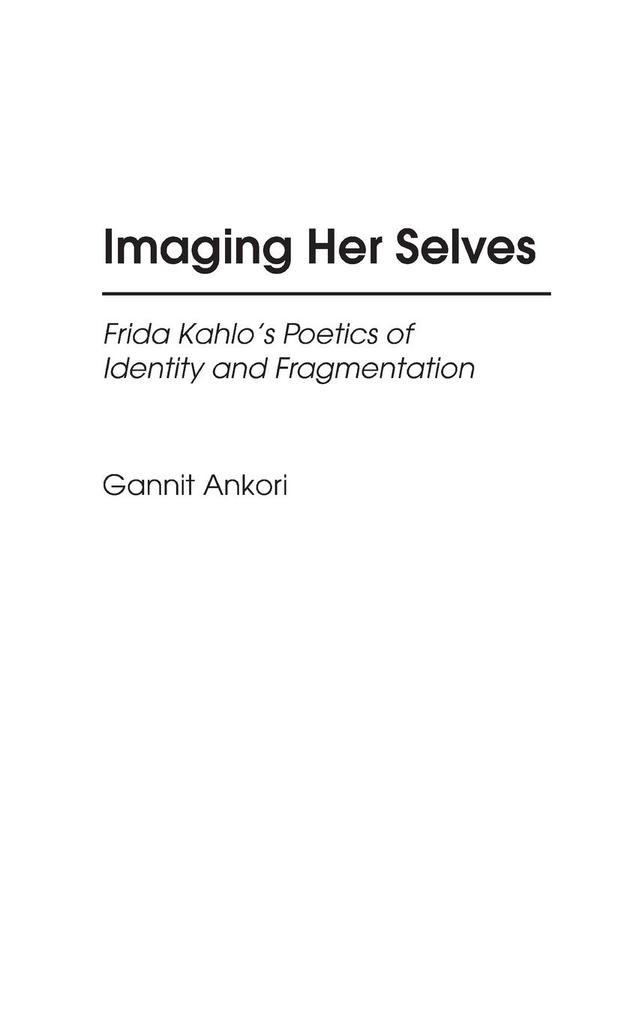
Zustellung: Mo, 02.06. - Do, 05.06.
Versand in 1-2 Wochen
VersandkostenfreiBestellen & in Filiale abholen:
Though often portrayed in scholarly literature as a spontaneous artist, Frida Kahlo worked in a quite deliberate manner, basing her paintings on diverse cultural and philosophical sources. Imaging Her Selves uncovers the unexplored visual and textual foundations of Kahlo's imagery, illustrating-through a detailed study of her diary, letters, library collection, and other material- the complex multilayered meanings of the many selves she comprised. In dozens of self-portraits, Kahlo examined the conventional and unconventional roles with which she attempted to identify. Ankori's work offers an innovative interpretation of her art as a major contribution to the ongoing human quest for a fuller understanding of the meaning of self.
Acknowledging her failure to conform to traditional female roles, such as that of wife and mother, Kahlo investigated alternative options. Her physical, metaphysical, social, and genealogical selves-including Lilith, La Llorona, La Malinche, the Crowned Nun, and the Hindu goddess Parvati- are all on display in her art. Transcending typical biographical inquiries, Ankori has created a broader study of the way in which Kahlo's art both reflected and refracted her multifaceted identity.
Acknowledging her failure to conform to traditional female roles, such as that of wife and mother, Kahlo investigated alternative options. Her physical, metaphysical, social, and genealogical selves-including Lilith, La Llorona, La Malinche, the Crowned Nun, and the Hindu goddess Parvati- are all on display in her art. Transcending typical biographical inquiries, Ankori has created a broader study of the way in which Kahlo's art both reflected and refracted her multifaceted identity.
Inhaltsverzeichnis
Preface
Introduction: Frida Kahlo's Search for Self
A Brief Biographical Outline
The Nascent Self: Where "I" Began
The Matrix
The Paternal Contribution
The Genealogical Self
The Child Self: Kahlo's Childhood Series
My Nurse and I
The Ousted Child: She Plays Alone
The Body-Self
The Broken Body, The Double Self
Displaying the Wounded Self
Revisioning the Female Bather
The Social Self
The Beloved and the Mexican Wife
The Maternal Self
Exploring Alternative Roles
The Pre-Social Self
The Androgynous Self
Trapped in a Web of Deceit and Betrayal
The Ascetic Self
Imitatio Christi
Emulating Christ's Mystic Bride
Merging Self and Other
Uniting with Rivera, Identifying with Parvati
The Ultimate Union: From Aham to Atman
Conclusion: The Fractured Self: Behind the "Triple Faç ade"
Select Bibliography
Introduction: Frida Kahlo's Search for Self
A Brief Biographical Outline
The Nascent Self: Where "I" Began
The Matrix
The Paternal Contribution
The Genealogical Self
The Child Self: Kahlo's Childhood Series
My Nurse and I
The Ousted Child: She Plays Alone
The Body-Self
The Broken Body, The Double Self
Displaying the Wounded Self
Revisioning the Female Bather
The Social Self
The Beloved and the Mexican Wife
The Maternal Self
Exploring Alternative Roles
The Pre-Social Self
The Androgynous Self
Trapped in a Web of Deceit and Betrayal
The Ascetic Self
Imitatio Christi
Emulating Christ's Mystic Bride
Merging Self and Other
Uniting with Rivera, Identifying with Parvati
The Ultimate Union: From Aham to Atman
Conclusion: The Fractured Self: Behind the "Triple Faç ade"
Select Bibliography
Produktdetails
Erscheinungsdatum
30. Januar 2002
Sprache
englisch
Seitenanzahl
336
Autor/Autorin
Gannit Ankori
Verlag/Hersteller
Produktart
gebunden
Gewicht
669 g
Größe (L/B/H)
240/161/23 mm
ISBN
9780313315657
Entdecken Sie mehr
Bewertungen
0 Bewertungen
Es wurden noch keine Bewertungen abgegeben. Schreiben Sie die erste Bewertung zu "Imaging Her Selves" und helfen Sie damit anderen bei der Kaufentscheidung.










